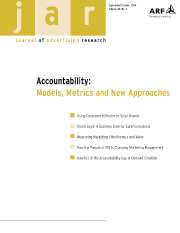Crossref Citations
This article has been cited by the following publications. This list is generated based on data provided by
Crossref.
Cauberghe, Verolien
and
Pelsmacker, Patrick De
2006.
Opportunities and Thresholds for Advertising on Interactive Digital TV.
Journal of Interactive Advertising,
Vol. 7,
Issue. 1,
p.
2.
Sinisalo, J.
Salo, J.
Karjaluoto, H.
and
Leppaniemi, M.
2006.
Managing Customer Relationships through Mobile Medium — Underlying Issues and Opportunities.
p.
112b.
Hall, Linda
and
Wickham, Mark
2008.
Organising IMC roles and functions in the business‐to‐business network environment.
Journal of Marketing Communications,
Vol. 14,
Issue. 3,
p.
193.
Winter, Susanna
and
Sundqvist, Sanna
2009.
IMC strategies in new high technology product launches.
Marketing Intelligence & Planning,
Vol. 27,
Issue. 2,
p.
191.
Chang, Yuhmiin
2009.
An exploration of the standardization of targeting strategies and the use of promotional disciplines on the web: A cross-national study.
Journal of Marketing Communications,
Vol. 15,
Issue. 5,
p.
327.
Kitchen, Philip J.
and
Burgmann, Inga
2010.
Wiley International Encyclopedia of Marketing.
Palakshappa, Nitha
Bulmer, Sandy
Eweje, Gabriel
and
Kitchen, Philip
2010.
Integrated strategic partnerships between business and not-for-profit organisations: A case study from New Zealand.
Journal of Marketing Communications,
Vol. 16,
Issue. 4,
p.
255.
Kerr, Gayle
and
Drennan, Judy
2010.
Same But Different—Perceptions of Integrated Marketing Communication Among Marketing Communication Partners in Australia.
Journal of Promotion Management,
Vol. 16,
Issue. 1-2,
p.
6.
Barreto, Matt A.
Merolla, Jennifer
and
Soto, Victoria Defrancesco
2011.
Multiple Dimensions of Mobilization: The Effect of Direct Contact and Political Ads on Latino Turnout in the 2000 Presidential Election.
Journal of Political Marketing,
Vol. 10,
Issue. 4,
p.
303.
Šerić, Maja
and
Gil-Saura, Irene
2011.
Integrated marketing communications and information and communication technology in the hotel sector: An analysis of their use and development in Dalmatian first-class and luxury hotels.
Journal of Retail & Leisure Property,
Vol. 9,
Issue. 5,
p.
401.
Šerić, Maja
and
Gil Saura, Irene
2011.
ANÁLISIS DE LOS HOTELES DE ALTA CATEGORÍA DE CROACIA DESDE EL ENFOQUE HOTEL-HUÉSPED.
Investigaciones Europeas de Dirección y Economía de la Empresa,
Vol. 17,
Issue. 3,
p.
127.
Smith, Brian G.
2012.
Organic integration: the natural process underlying communication integration.
Journal of Communication Management,
Vol. 16,
Issue. 1,
p.
4.
Smith, Brian G.
2012.
Communication integration: An analysis of context and conditions.
Public Relations Review,
Vol. 38,
Issue. 4,
p.
600.
Sundstrom, Beth
2012.
Integrating Public Relations and Social Marketing.
Social Marketing Quarterly,
Vol. 18,
Issue. 2,
p.
135.
Jerman, Damjana
and
Završnik, Bruno
2012.
THE MODEL OF MARKETING COMMUNICATIONS EFFECTIVENESS: EMPIRICAL EVIDENCE FROM SLOVENIAN BUSINESS-TO-BUSINESS PRACTICE.
Journal of Business Economics and Management,
Vol. 13,
Issue. 4,
p.
705.
Šerić, Maja
and
Gil-Saura, Irene
2012.
ICT, IMC, and Brand Equity in High-Quality Hotels of Dalmatia: An Analysis From Guest Perceptions.
Journal of Hospitality Marketing & Management,
Vol. 21,
Issue. 8,
p.
821.
Reinold, T.
and
Tropp, J.
2012.
Integrated marketing communications: How can we measure its effectiveness?.
Journal of Marketing Communications,
Vol. 18,
Issue. 2,
p.
113.
Demajorovic, Jacques
Huertas, Melby Karina Zuniga
Boueres, Juliana Alves
Silva, Adilson Gonçalves da
and
Sotano, Aloisio Sousa
2012.
Logística reversa: como as empresas comunicam o descarte de baterias e celulares?.
Revista de Administração de Empresas,
Vol. 52,
Issue. 2,
p.
165.
Šerić, Maja
Gil-Saura, Irene
and
Mollá-Descals, Alejandro
2013.
Loyalty in High-Quality Hotels of Croatia: From Marketing Initiatives to Customer Brand Loyalty Creation.
Journal of Relationship Marketing,
Vol. 12,
Issue. 2,
p.
114.
Tafesse, Wondwesen
and
Korneliussen, Tor
2013.
Examining the effect of using multiple media tools on the marketing performance of organizations in a trade campaign environment.
Journal of Marketing Communications,
Vol. 19,
Issue. 3,
p.
215.


